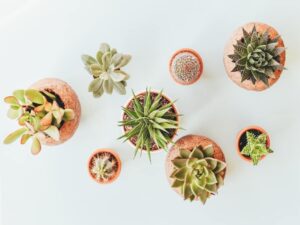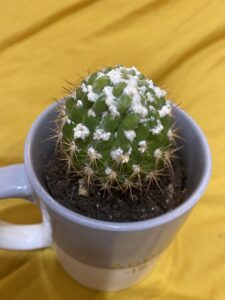When you gaze upon a brightly flowered plant in a pot, is it not tempting to imagine having a similar verdant beauty bless your indoor space? A common question arises: How can one successfully cultivate a cactus in a flower pot? While these resilient enigmas of the plant kingdom are often perceived as low-maintenance, there exists a plethora of nuanced requirements essential for their thriving. Let us embark on a journey deep into the enchanting world of cacti cultivation, exploring the intricacies that could challenge even the most seasoned plant-lover.
In this discourse, we will explore the fascinating aspects of growing cacti in pots, elucidate critical considerations, and unveil proven strategies that will lead to flourishing, healthy specimens. Understanding the nuances of pot selection, soil composition, watering methodology, and light requirements is pivotal to overcoming the hurdles inherent in cactus husbandry.
Choosing the Right Pot: Beyond Aesthetics
The pot serves as the foundational environment for your cactus. It is essential to consider not solely aesthetics but also functionality. When selecting a pot, ensure it features adequate drainage holes—these allow excess water to escape, preventing the dreaded phenomenon of root rot.
Cacti typically possess shallow root systems; thus, a pot that is wider than it is deep is preferable. This configuration facilitates side root growth, which can be more beneficial than deep growth in accommodating the cactus’s natural behavior. Terracotta pots are an excellent choice due to their porous nature, which allows air exchange while assisting moisture evaporation. However, be wary of any heavy decorative pots that may retain moisture longer than ideal.
Soil Composition: Crafting the Perfect Mixture
Another critical aspect to consider is the potting mix. Cacti thrive in well-draining substrate that mimics their arid desert habitats. A suitable potting mix typically consists of a combination of potting soil, sand, and perlite or pumice. This combination provides sufficient drainage while retaining necessary nutrients.
Commercial cactus potting mixtures are available, yet crafting your own allows customization specific to your cactus variety. A standard ratio is two parts potting soil to one part sand and one part perlite. This concoction enables proper aeration and drainage while maintaining a bit of moisture to sustain your cactus’s growth.
Watering Wisely: The Delicate Balance
Watering may pose one of the most significant challenges to cactus caretakers. The infrequent yet thorough watering regime is crucial. Overwatering is often fatal; thus, understanding the nuances of this process is imperative. During the growing season, typically spring and summer, watering every two to three weeks is sufficient. Allow the top inch of soil to dry out between watering to prevent the roots from dwelling in moisture.
In contrast, during the dormant winter season, your cactus will require even less. Water can be reduced to once a month or even less frequent for some varieties. Observing your cactus for signs of dehydration, such as shriveling, can indicate a need for water. Conversely, yellowing or mushy stems signal overwatering, necessitating immediate remedial action.
Light Conditions: Dialing It In
Light requirements are another pivotal aspect in ensuring your cactus flourishes. While cacti can often tolerate low-light conditions to some extent, they thrive under bright, direct light for several hours a day, ideally around six hours. A south or west-facing window is often the optimal choice in homes. Should natural light availability be limited, consider using grow lights to supplement illumination during shorter days.
However, be cautious not to expose your cactus to the infamous ‘burning’ effect of intense, direct sunlight for prolonged periods, especially if they have been recently acclimated to indoor light levels. Gradually introducing cacti to brighter conditions can be an effective strategy to mitigate stress, ensuring their vibrant health.
Fertilization Fundamentals: Nourishing Your Cactus
While cacti are frequent residents of nutrient-poor environments, it is prudent to provide them with some nourishment during their active growth periods. Fertilizing during the growing season can greatly enhance growth rates and flowering potential. A diluted liquid fertilizer, specifically formulated for cacti and succulents, should be used approximately once a month during spring and summer.
Over-fertilization can be counterproductive and lead to salt build-up in the soil, so moderation is key. It is advisable to flush the pot every few months with pure water to prevent salt accumulation and ensure a balanced environment.
When Challenges Arise: Problem-Solving Strategies
Even with diligent care, challenges may arise. Pests can be a concern, particularly mealybugs and spider mites. Regular inspections are vital, and when encountered, treatments should be swift—neem oil or insecticidal soap can be effective in managing infestations.
Additionally, environmental factors can provoke symptoms such as soft, mushy stems or discolored leaves. Adjusting watering frequency, light exposure, and humidity levels can combat such issues, returning your cactus to its glorious state.
Conclusion: Cultivating an Enthralling Cactus Collection
In conclusion, successfully cultivating cacti in pots requires careful attention to various elements, from pot selection and soil composition to watering practices and light exposure. Embracing the challenges and nuances of cactus care can lead to a delightfully rewarding gardening experience. With patience and attention, your cactus collection can flourish, rewarding you with their unique charm and beauty, brightening your indoor oasis.





Leave a Comment